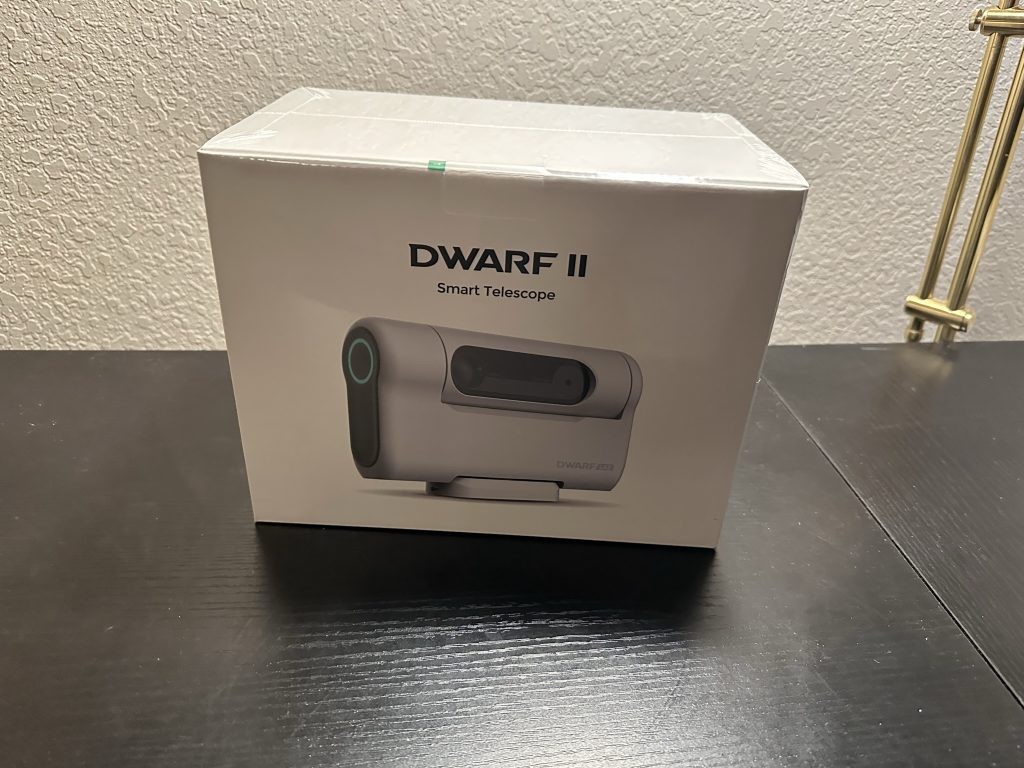
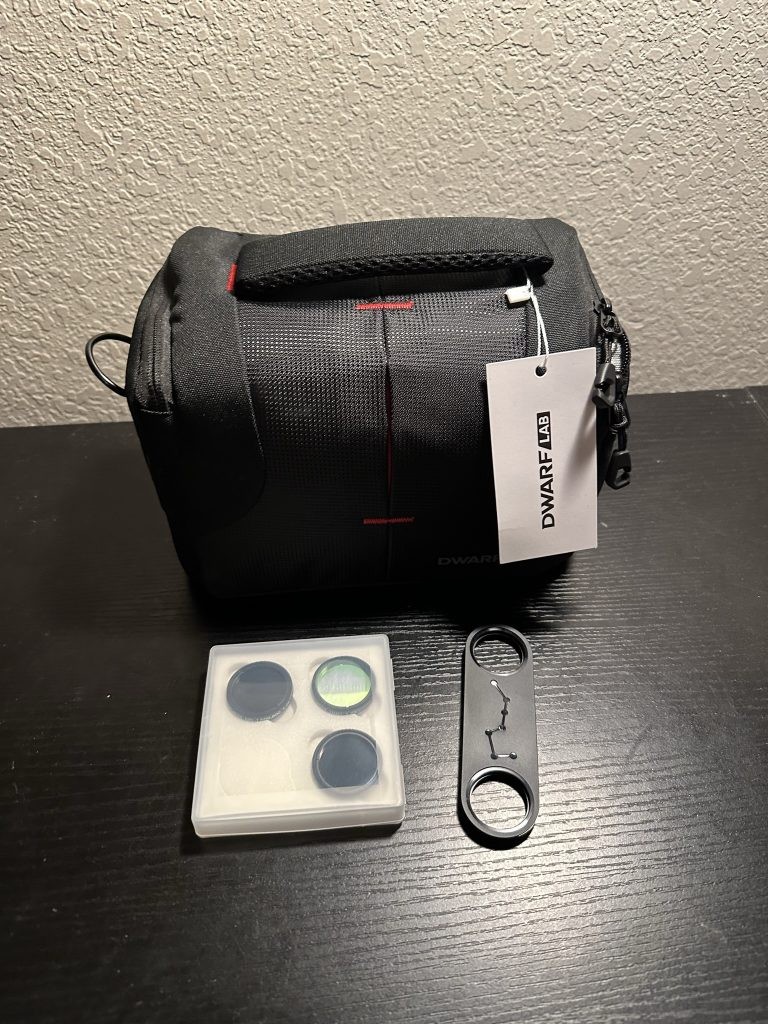
I consider the DwarfLab Dwarf II telescope to be a very versatile instrument, boasting dual objectives that cater to both wide-field and narrow-field observations.
The Dual Lenses: Telephoto & Wide Angle

The telephoto lens with the stock sensor reaches a 3-degree field of view (FOV), whereas the wide-angle lens gives an expansive 50-degree FOV.
When it comes to resolution, the Dwarf II’s telephoto lens has an 8-megapixel sensor, which translates to an image dimension of approximately 3264 x 2448 pixels. On the other hand, a 2-megapixel sensor, which is equivalent to around 1920 x 1080 pixels, supports the wide-angle lens.
DwarfLab claims both are running off SONY IMX415 Starvis sensors, with the wide-angle lens just compressing (binning) the pixels into larger ones. The IMX415 Starvis is a security camera sensor designed for high frame rates as well as low-light situations. But I think the resulting ability of Dwarf II to take video at high frame rates is fairly useless for astronomical purposes, given that it is far too small and short in focal length to use such a capability for planetary imaging.
The Dwarf II shifts internal lenses and other components to focus and does so extremely quickly. It also features auto-focus built into its software. Unlike a DSLR or smartphone camera, however, there is no iris mechanism to adjust the f-stop of either of the Dwarf II’s objectives.
Accessories with Basic & Deluxe Editions
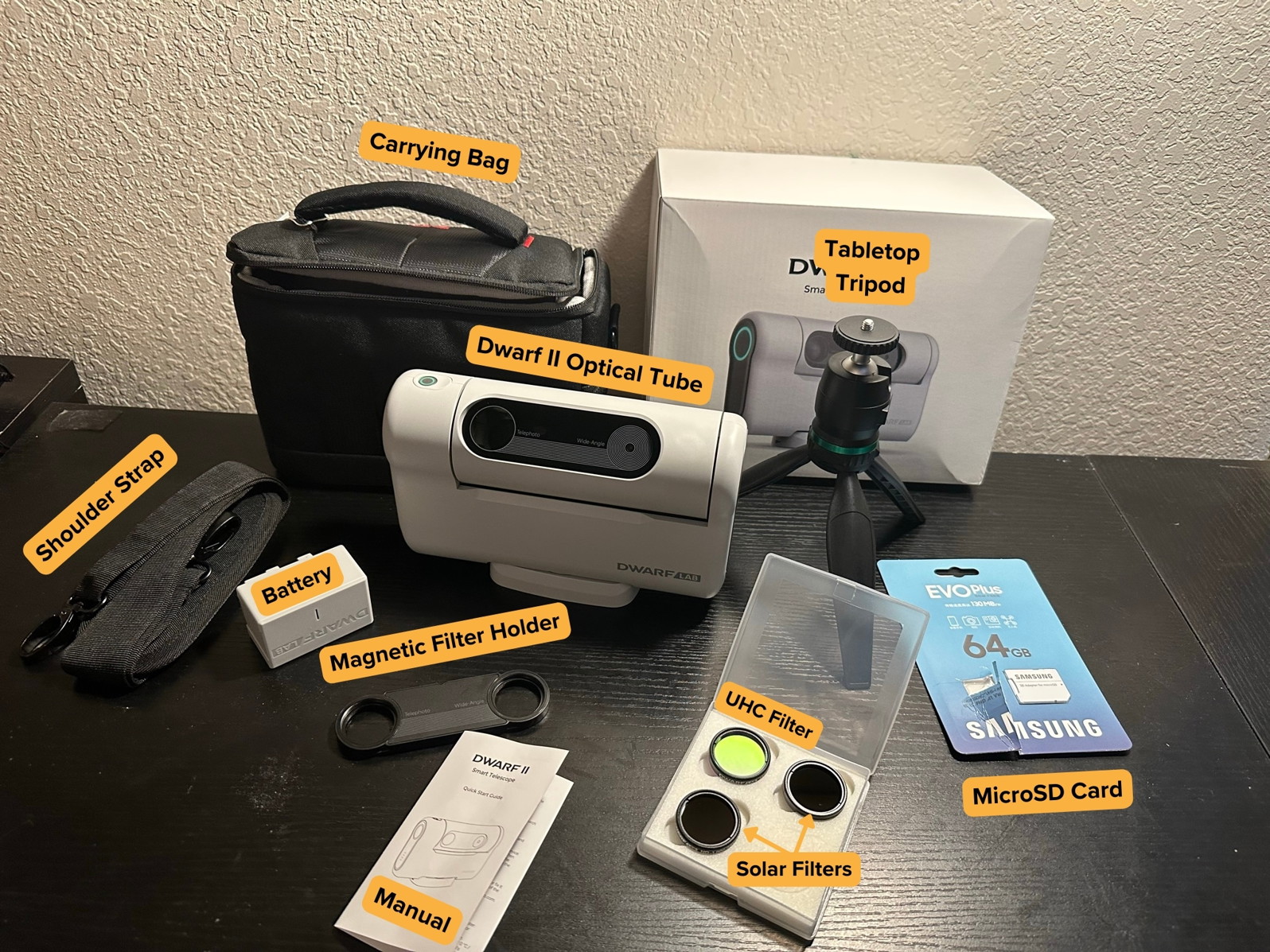
The Dwarf II’s basic package (Classic Edition) includes no accessories besides a microSD card and a well-designed carry bag that holds the Dwarf II, its tripod, and any additional necessary items.
The “Deluxe Edition” Dwarf II that I received included a filter holder as an extra, along with two solar filters and a “UHC” filter. I also got an additional battery with the deluxe kit that I could keep as a backup for times when the default lithium battery runs out.
There is no charger provided with the Dwarf II base or deluxe packages. You’ll have to source a USB-C charger yourself.
The “UHC” filter (actually a broadband light pollution filter) can be screwed onto the magnetic filter holder in front of either the telephoto or wide-angle objectives. It works well for imaging nebulae with the Dwarf II, slightly decreasing the background sky glow. But with a standard telescope eyepiece, I find it fairly useless.
Caution: Solar Viewing with The Provided Filters
For solar viewing with the Dwarf II, you are supposed to screw on the provided pair of 1.25” “ND” solar filters to the provided filter holder that can be magnetically attached to the front of the lenses. These solar filters are definitely not safe for looking directly with your unaided eye or even by attaching the solar filter to a regular telescope eyepiece. This makes them especially dangerous to put in a 1.25” format.
From what I’ve seen over the years, there is eventually going to be some curious user who threads a Dwarf II solar filter onto their eyepiece. Any safe white-light solar filter (including the ones supplied with the Dwarf II) must go on the FRONT end of the telescope, not the front end of the eyepiece.
Attempting to screw one of these filters onto a standard 1.25” telescope eyepiece or star diagonal will likely work for a short while. But it will also allow UV rays from the Sun to pass through, which can damage your retina. Eventually, the placement of the filter near the focal plane will cause it to crack from the intense focused light and heat of the Sun, which will result in the destruction of the filter, possibly your eyepiece and send a beam of unfiltered sunlight straight out of the telescope to set ablaze any nearby objects or fry your retina. It need not even be stated: do not try this.
While I’ve witnessed Dwarf II’s solar filters working fine, I still believe that it’s an idiotic decision from DwarfLab to make them in 1.25” format for the reasons stated above. In my opinion, the whole filter assembly should clip on in place of the 1.25” filter adapter, which would be quicker anyway.
Mount & Tripod
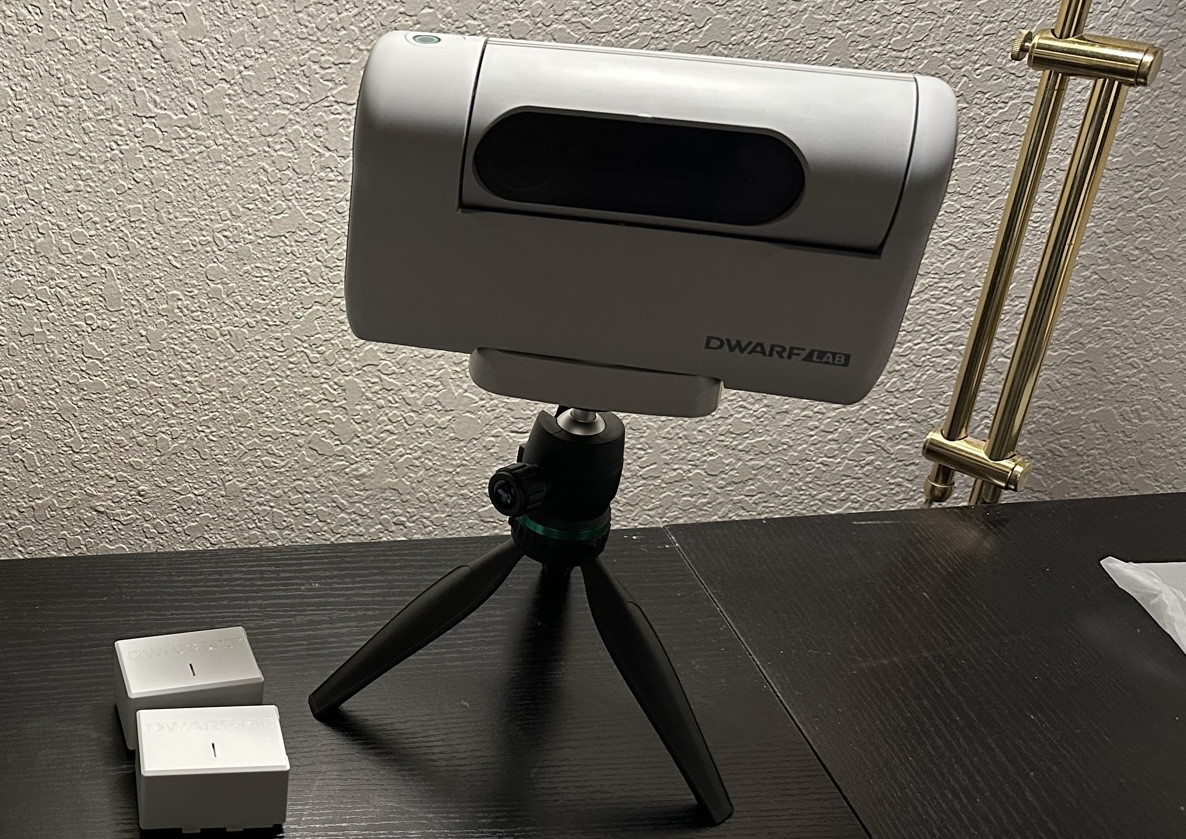
The Dwarf II rides on a tiny alt-azimuth mount that is fully motorized with stepper motors. It can move at a maximum speed of about 30 degrees per second and has a 3.6-arcsecond resolution. I found the latter to be an utterly abominable specification for a typical telescope mount, but given how tiny the Dwarf II is, it doesn’t matter too much.
Interestingly, the Dwarf II has no clutches or encoders of any kind. It tracks using automatic image recognition, so in my experience, it does not really matter if you manually grab or jostle it as long as it is not taking a long exposure. The Dwarf II automatically slews to deep-sky objects, the Moon, and the planets from an internal database and does so solely based on plate-solving of a reference area of the sky, without any user input. This is made possible by the generous field of view and the fairly low resolution of both cameras/telescopes.
Based on my assessment, being on an alt-azimuth mount with fairly low-resolution stepper ticks, the Dwarf II has issues with field rotation over periods longer than about 30 minutes of stacked exposures. This limits the total amount of time I could capture deep-sky objects. In my trials, the alt-azimuth and low-resolution nature of the mount’s tracking, combined with a lack of guiding or balance and the often too-light tripods used below the telescope, often caused me to experience trailing in long-exposure astrophotos.
The Dwarf II also comes with a tiny, folding plastic tabletop tripod with a ball head. It fits inside the provided case with the telescope. However, in my experience, it is far too light and wobbly to support the Dwarf II properly. A proper photo tripod is a must for this device.
Software: The Good & Bad
The Dwarf II’s main selling points are really more in the telescope’s provided software, and it’s easy to see why. Here are some of the main features that are advertised and do, in fact, come with the Dwarf II app:
- Automatic tracking of celestial objects & live stacking of deep-sky images
In my testing, I found that the tracking and stacking done by the Dwarf II is pretty seamless. However, it isn’t perfect with long-exposure astrophotos; a little bit of trailing is inevitable, which is disappointing for such a short focal length instrument. Despite this, I observed that the images were recognizable and fairly crisp.
The Dwarf II also tracks the Sun based solely on real-time software estimating its drift, which I found convenient. This is a unique feature that I haven’t seen any other automated telescopes demonstrate before.
- Easily-swappable wide-angle/main camera views
The swapping of the wide-angle and main camera views of the Dwarf II is pretty high-tech, and I appreciate that we can manually adjust the alignment of the two. However, I found it a bit too easy to accidentally misalign the two cameras, and there is no way to automatically re-sync them; I had to align them again by hand.
- Joystick Pointing
The joystick pointing of the Dwarf II is again unprecedented and is a lot cooler than the right-angle or diagonal angles of hand controllers or most other smart device-to-telescope interfaces. A slider on the right of the screen for your other thumb can be toggled to adjust the sensitivity of the joystick. However, I found the sensitivity at the lower end hard to fine-tune.
- Impressive AI Integration, But Not Without Issues
I was impressed by the AI-powered image recognition of the Dwarf II, which really feels like something out of Tony Stark’s lab rather than a sub-$1000 product. Clearly, the designers made a legitimate attempt to make it work.
However, in my use, I found that tracking is limited to the confines of the narrow-angle camera view, and image recognition fails with all but the most evenly-illuminated and high-contrast objects. It could not track birds or other wild animals, let alone satellites, rockets, or even slow-moving planes, to any degree of accuracy (or at all; it would just stop after a second or two).
- Mobile App & Its Glitches That I Experienced
The Dwarf II app is fairly well-designed but extremely glitchy.
In addition to the issues I’ve already mentioned, it sometimes fails to connect to the telescope, gets stuck between “astronomy” and “regular” camera modes, freezes/crashes, or sends the telescope flailing wildly about when I try to aim the joystick. The focusing mechanism can also fail to respond to commands, either manual or auto-focus. This all happened to me in a 30-minute session multiple times.
These problems are exacerbated by the Dwarf II’s tendency to overheat, which also causes the telescope/app to become unresponsive.
Notable Heat Issues
Unfortunately, I’ve noticed that in addition to software bugs, the Dwarf II seems to have heat management issues.
The Dwarf II is powered by fairly standard batteries, similar to the clip-in units for a DSLR. These are not low-quality batteries that you should have to worry much about them catching fire, etc. from quality issues.
However, there is something wrong with the Dwarf II itself.
During my test, the Dwarf II quickly overheated on a September morning around room temperature when pointed at the Sun (a task for which it is designed and marketed as being useful). It became unable to adjust focus, and it did not respond consistently to motor commands. Later in the day, it froze up entirely in the Arizona heat. Obviously, that’s a bit of an extreme use case, but you should be able to point this telescope at the Sun on a pleasant day without problems at the very least.
I’ve also seen other users of Dwarf IIs reporting that the unit seems to heat up at substantially lower temperatures, citing that these telescopes can still be warm to the touch under near-freezing conditions (though without any malfunctions). While I appreciate that Dwarflab has thoughtfully provided this anti-dew and anti-frost feature, I think it is a serious cause for concern, both for the longevity of the unit and for general safety purposes.
Should I buy a Used Dwarf II?
I would not recommend buying a used Dwarf II.
There is no servicing of Dwarf II units aftermarket in any capacity, and doing it yourself is next to impossible. A used unit may also have hardware or software problems that are not disclosed by the seller.
What can you do with the Dwarf II?
The Dwarf II is primarily billed for terrestrial use, and I found it quite fun to play around with.
I appreciate how I can use my fingers to digitally zoom in either view, and it’s extremely easy to pan the whole thing around with the joystick. Think of it as kind of like a security camera with a better lens and the ability to point anywhere we want.
A proper spotting scope would give me better views, sure, but I like that the Dwarf II focuses automatically and lets me snap pictures with the push of a button.
The Dwarf II’s tendency to overheat exacerbates the already-present software bugs in many outdoor settings, and as mentioned, the AI tracking feature simply does not function as advertised. However, it will still work for close-up views of birds, whales, distant landmarks, etc.
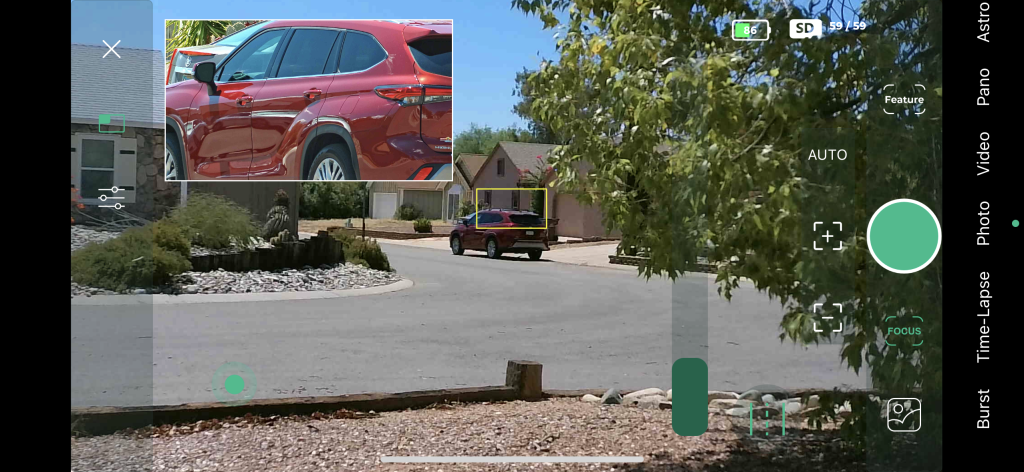
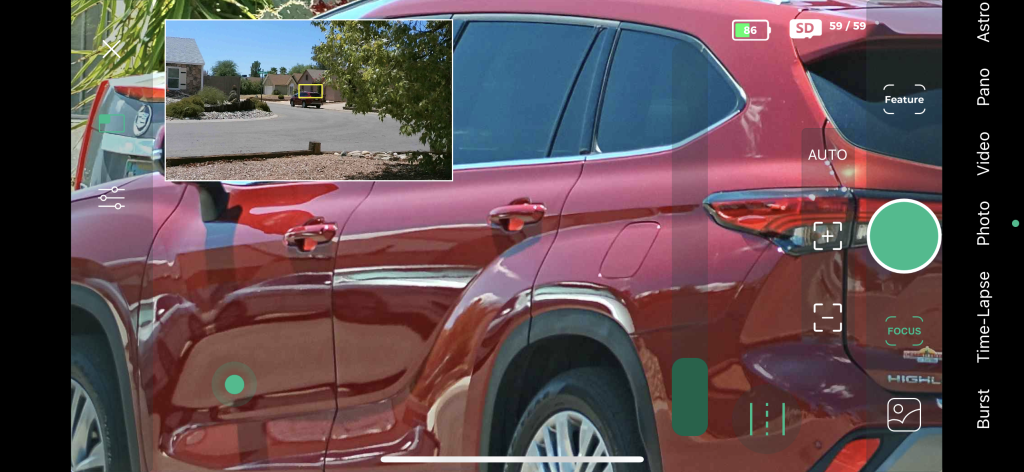
Astrophotography Capabilities
In my evaluation, I found that the Dwarf II features an impressive amount of software for astrophotography, with the ability to automatically take dark and flat frames for calibration and noise reduction purposes. The live stacking gradually combines multiple short exposures into a single image, and you can see the brightness and detail progressively build up with each frame.
The short focal length and low resolution of both of the Dwarf II’s cameras mean it’s primarily suited for wide-field astrophotography targets. I noted that the Dwarf II will show me the basic features of the Moon and planets, but it’s about as good as a pair of high-power binoculars in this regard—vastly inferior to even a fairly cheap telescope
- Deep-Sky Targets
Large open star clusters like the Double Cluster, the Andromeda Galaxy, and the Veil Nebula are good examples of the kinds of targets that will produce satisfactory images through the Dwarf II.
In my experience, smaller targets like globular clusters and more distant galaxies like the Leo Triplet are recognizable in long-exposure images through the Dwarf II but are far from impressive. Some trailing in your images is also pretty much inevitable.
- Solar System Targets
This is a telescope/camera designed for wide fields; it is far too small and lacking in focal length for close-ups of Solar System objects.
I could see craters on the Moon, the moons and bands of Jupiter, the phases of Venus, and the rings of Saturn. Mercury and Mars are little more than fuzzy blurs. You can’t distinguish Uranus or Neptune from stars. Fine detail on the Moon or the gas giant planets is nonexistent in Dwarf II images.
I guess the most interesting Solar System object to observe with the Dwarf II would be the Sun. In theory, the Dwarf II allows you to view sunspots from the comfort of the shade or indoors remotely, thanks to its automatic tracking and white-light solar filters. However, as I shared before, the Dwarf II will often overheat if pointed at the sun, even on a fairly brisk day, which causes focus and tracking operations to grind to a halt.




The Dwarf 2 does not show cloud bands on Jupiter or rings of Saturn. Focal length is far too short.
I was able to see them albeit barely, the focal length fundamentally isn’t what matters but rather the image/pixel scale
I got a DWARF II, and really like it. I am an amateur astronomer, use DWARF II to shoot the Sun, Moon and DSO, easy to use, and the tiny size rocks.
Totally agree 100%. The YouTube videos are people who got the Dwarf 2 for free so are forced to make it look good as possible but all are fake reviews. I am an amateur astronomer. I only expected minimum results but got no results. Numerous types of errors and no list of what these errors mean and how to correct it and their website is useless. I got it to track once but the image was so bad I was about to throw it away and taking pictures through anything with a cell phone would give you better pictures at 1/20th the cost of this thing. It may be ok for land tracking but why spend this amount of money when you can buy other cameras that do the same thing with better resolution and much smaller and cheaper.
I don’t even think it’s that disingenuous. Dwarflab is handing free Dwarf 2s out like candy (probably because they cost relatively little to produce and the margin on them is high) to people to review. I found myself writing off a lot of its problems at first because I had gotten sent a complimentary unit. I can easily see how just being happy with a free one and little knowledge of telescopes could easily translate into an over-enthusiastic review.
I own quite a few large telescopes and astro photo eq. I bought the Dwarf, for it’s ease of use away from my home due to the limited sky view of the N. Georgia trees on the property. I was amazed it plate solved the first time among the trees. I did manually point the lens up 45 degrees before turning it on. It tracked M42 easily. I haven’t spent enough time learning the app yet to take any decent images. But the fact is it did auto focus, and the stars were fairly sharp with 1`5 sec. exposures, about like my iOptron Az Mount Pro and it’s field rotation issues. Also note, you can use the Dwarf in the equatorial mode unlike my AZ Mount Pro. When I put it away, I realized I hadn’t removed the protective plastic film from the lens! Looking at the results many are getting on the Facebook forums, I would be inclined to disagree with most of the negative comments in the article. For those considering a Dwarf II, I highly recommend joining some of the FB forums, then decide if it is right for you. Mind you, it certainly will not come anywhere near the views my 8 inch ACF and refractor scopes deliver for planetary observation. In my opinion, it is a great and easy way to jump into astrophotography on the cheap, with respectable results. I have no affiliation with any company, just an average amature astronomer. I paid full price for my Dwarf II. 😉
I see Dwarf 3 out in the market. Could you please post your review on that ? I see ZWO Seestar S50 is comparable to Dwarf 3. I’m debating between them.